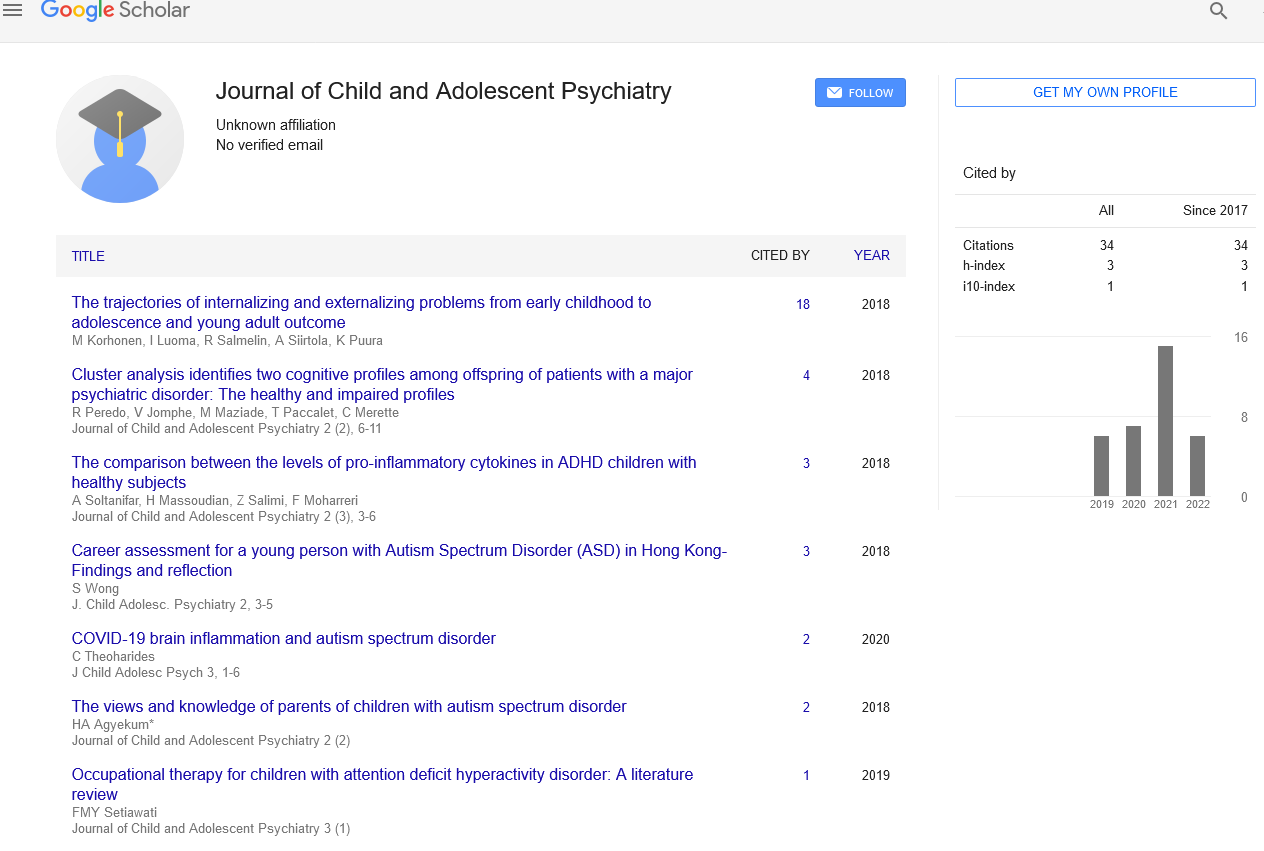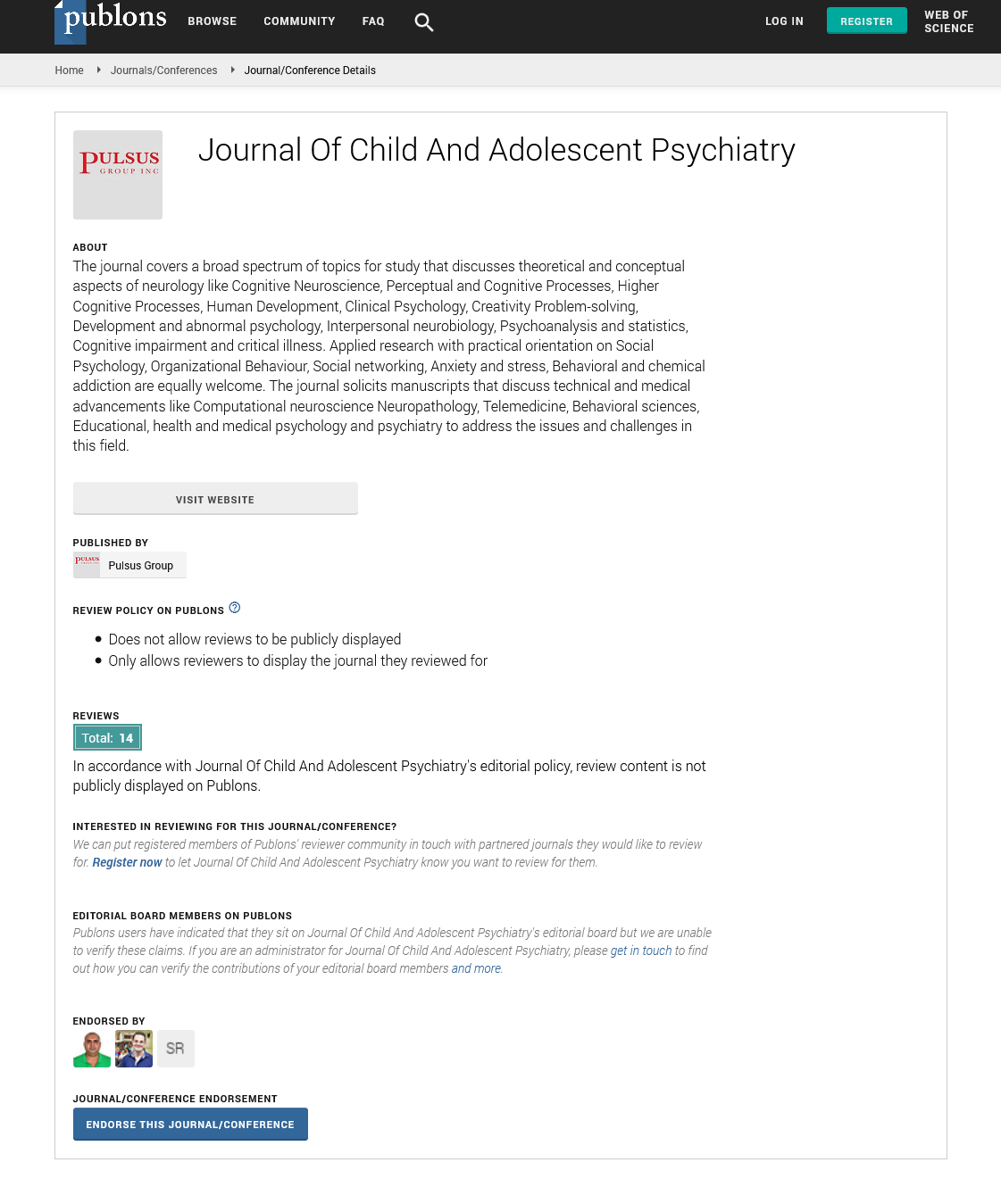Adolescent mental health an overview
Received: 05-Mar-2021 Accepted Date: Mar 18, 2021; Published: 25-Mar-2021
Citation: Zezhi Li, Adolescent mental health an overview.Child and Adolescent Psychiatry. 2021;5(2):e001.
This open-access article is distributed under the terms of the Creative Commons Attribution Non-Commercial License (CC BY-NC) (http://creativecommons.org/licenses/by-nc/4.0/), which permits reuse, distribution and reproduction of the article, provided that the original work is properly cited and the reuse is restricted to noncommercial purposes. For commercial reuse, contact reprints@pulsus.com
Description
Youth (10-19 years) is an extraordinary and developmental time. Numerous physical, enthusiastic and social changes, including openness to neediness, misuse, or savagery, can make youths helpless against psychological wellness issues. Advancing mental prosperity and shielding young people from unfavorable encounters and danger factors that may affect their capability to flourish are basic for their prosperity during youthfulness and for their physical and emotional wellness in adulthood.
Youthfulness is a critical period for creating and keeping up friendly and enthusiastic propensities significant for mental prosperity. These incorporate receiving solid rest designs; taking normal exercise; creating adapting, critical thinking, and relational abilities; and figuring out how to oversee feelings. Steady conditions in the family, at school and in the more extensive local area are additionally significant.
Different elements decide psychological wellness results. The more danger factors teenagers are presented to, the more noteworthy the likely effect on their psychological wellness. Brutality (counting cruel nurturing and tormenting) and financial issues are perceived dangers to psychological wellness. Youngsters and teenagers are particularly defenseless against sexual brutality, which has an unmistakable relationship with adverse emotional wellness.
A few youths are at more serious danger of emotional well-being conditions because of their everyday environments, shame, segregation or prohibition, or absence of admittance to quality help and administrations. These incorporate youths living in helpful and delicate settings; young people with constant ailment, mental imbalance range issue, a scholarly incapacity or other neurological condition; pregnant teenagers, juvenile guardians, or those in right on time as well as constrained relationships; vagrants; and teenagers from minority ethnic or sexual foundations or other segregated gatherings.
Passionate issues ordinarily arise during youth. Notwithstanding melancholy or nervousness, young people with passionate problems can likewise encounter unnecessary peevishness, disappointment or outrage. Side effects can cover across more than one enthusiastic issue with fast and unforeseen changes in state of mind and passionate upheavals. More youthful young people may also create feeling related actual side effects, for example, stomach hurt, cerebral pain or queasiness.
Youth conduct issues are the subsequent driving reason for illness trouble in youthful teenagers matured 10-14 years and the 11th driving reason among more established young people matured 15-19 years. Youth social issues incorporate consideration deficiency hyperactivity problem (described by trouble focusing, unnecessary action and acting without respects to outcomes, which are usually not fitting for an individual's age), and lead issue (with manifestations of damaging or testing conduct). Youth social issues can influence teenagers' schooling and may bring about criminal conduct.
An expected 62 000 teenagers kicked the bucket in 2016 because of selfhurt. In older young people, self-destruction is the third leading cause of death (15-19 years). Almost 90% of the world's young people live in low-or center pay nations and over 90% of juvenile suicides are among teenagers living in those nations. Danger factors for self-destruction are multi-layered, including unsafe utilization of liquor, maltreatment in youth, shame against help-chasing, boundaries to getting to mind and admittance to implies. Correspondence through computerized media about self-destructive conduct is an arising worry for this age gathering.
Conditions that incorporate indications of psychosis most generally arise in late youthfulness or early adulthood. Side effects can incorporate fantasies or hallucinations. These encounters can impede a juvenile's capacity to take an interest in day by day life and instruction and frequently lead to disgrace or basic liberties infringement. Many danger taking practices for wellbeing, for example, substance use or sexual danger taking, begin during youth. Danger taking practices can be both a pointless technique to adapt to poor psychological well-being and can seriously affect a young adult's psychological and actual prosperity.
Around the world, the commonness of substantial rambling drinking among youths matured 15¬-19 years was 13.6% in 2016, with guys most in danger. Tobacco and cannabis use are both reasons for concern. Cannabis is the most commonly used drug by children, with about 4.7 percent of 15-16- year-olds using it at least once in 2018. Many adult smokers start smoking before they reach the age of eighteen. It is essential to address the requirements of teenagers with characterized psychological well-being conditions. Staying away from regulation and over-medicalization, focusing on non-pharmacological approaches, and regarding the privileges of kids in accordance with the United Nations Convention on the Rights of the Child and other basic liberties instruments are key for youths.






